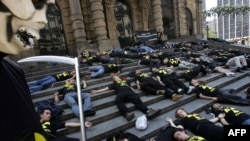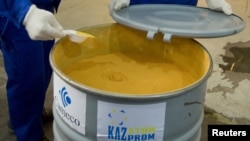WASHINGTON -- The arrest of seven members of an organized crime gang in Moldova in late 2014 was unremarkable for a part of the world where such underworld networks run rampant, except for what authorities said they were trafficking in: uranium-238.
Like its chemical cousin, uranium-235, uranium-238 is radioactive. The difference between the two is that uranium-235 is the central ingredient in building a nuclear weapon, a task that requires technical sophistication and specialized equipment.
Uranium-238, many law enforcement and nuclear experts fear, could be the central ingredient in building a dirty bomb, which would cause few immediate casualties but spread cancer-causing radioactive material over a wide area.
The danger that a terrorist group could acquire some sort of radiological material and use it to wreak havoc is central to the Nuclear Security Summit that opens in Washington on March 31. Dozens of leaders and delegations around the world will be discussing ways to keep potentially dangerous substances out of terrorists' hands.
By all accounts, that effort is an uphill battle.
Radiological substances lurk not only in nuclear power plants and military bases, but also in hospital diagnostic equipment, cancer treatments, mining machinery, household smoke detectors, and at one time, even lighthouses. Incidents like what happened in Moldova have occurred with unsettling regularity.
According to data compiled by the International Atomic Energy Agency (IAEA), the United Nations' nuclear watchdog, there were nearly 1,150 incidents involving theft, criminal possession, or loss of radiological material reported between 1993 and 2014. The James Martin Center for Nonproliferation Studies in California recorded 325 incidents alone between 2013 and 2014 in 38 different countries where nuclear or radioactive material was stolen, lost, or outside of regulatory control.
Here's a look at just a few incidents involving theft or mishandling of radioactive materials that have raised alarm bells.
The Georgian Connection
Georgian police in 2012 arrested three men in the Black Sea port of Batumi who were negotiating over the sale of cesium -- a radioactive substance used in drilling oil and gas wells, among other things. One of the would-be buyers also reportedly indicated he was interested in buying uranium.
The investigation found the seller possessed two substances -- cesium-137 and strontium-90 -- but not enough to be useful in building a dirty bomb. Strontium-90 has been used as a heat and power source for things like satellites, and also, in the Soviet era, lighthouses that were too remote to be manned or maintained regularly.
The arrest came in the same month that Georgian authorities arrested smugglers from the breakaway region of Abkhazia who were carrying about a kilogram of yellowcake uranium, a lightly processed substance typically made up of uranium-238. Though it has low radioactivity, yellowcake can be enriched to a higher level of radioactivity with enough technical know-how.
Georgia has seen an alarming number of investigations into alleged nuclear smuggling in the past decade following the creation of a special police unit in 2005.
Central Asian Cesium
Kazakh police in 2013 arrested a mining company engineer and three others for allegedly trying to sell a substance containing cesium-137. The engineer reportedly stole the substance from a warehouse at a mine company's enrichment plant in 1991, and stored it until deciding to give it to the three other accomplices to sell. The group had sought $250,000 for the materials. After being caught in a sting operation, the group claimed it did not know there was any danger from the cesium.
Kazakhstan is also among the world's largest producers of uranium ore, and is looking to build enrichment plants in the coming years to manufacture fuel for nuclear power plants around the world.
The German Sting
Two Spaniards and a Colombian man flying from Moscow were arrested in 1994 by German authorities at Munich airport while carrying 560 grams of mixed oxide reactor fuel, about two-thirds of which was another key ingredient to making an atomic bomb: plutonium-239.
The actual source of the material in Russia was never definitively identified, but the arrests, coming as Russia was still reeling from the collapse of the Soviet Union, stoked fears that the vast nuclear complex that Moscow inherited was riddled with security problems -- and that global underground markets would be flooded with dangerous materials.
The incident later became a major political scandal in Germany after lawmakers discovered the arrests were a sting operation organized by the lead German security agency to entrap would-be nuclear smugglers.
The Drunken Sailor And The Uranium
In 1993, a Russian navy officer and another man employed at a submarine base cut a hole in a perimeter fence at a fuel storage depot at the Sevmorput shipyard near the Arctic port of Murmansk. They proceeded to steal three fuel rods containing highly enriched uranium and stored the rods in the man's garage for seven months, intending to sell the material for $50,000. Later, however, the navy officer boasted about the theft to other officers while intoxicated, and authorities arrested both men.
The ease with which the men entered the facility highlighted glaring weaknesses in security for Russian radiological materials. The U.S.-government funded Cooperative Threat Reduction Program spent billions to help Russia pay for surveillance cameras, hi-tech sensors, and security guard salaries, as well the dismantling of missile warheads, submarines, and other weaponry that could potentially be stolen or smuggled.
Deadly Scrap
After a medical research laboratory in the central Brazilian city of Goiania moved to a new facility, some equipment was inadvertently left behind, including machinery used for medical radiation therapy. Scavengers in 1987 took some of the equipment's parts to sell for scrap, but discovered that the contents of one part glowed in the dark. Not realizing the substance contained cesium-137, they shared it with others in their neighborhood.
In the end, four people died of radiation poisoning and thousands others were contaminated. Brazilian officials removed vast quantities of top soil, and destroying several buildings and detected contamination in dozens of others.
In a comprehensive report, the IAEA called the Goiania contamination the "most serious radiological incident to have ever occurred to date."

